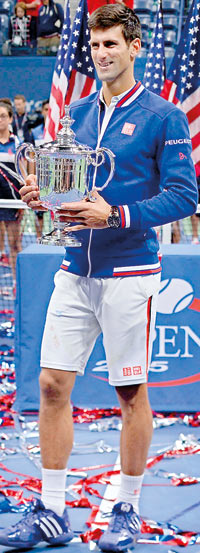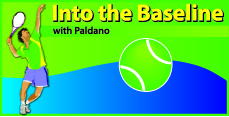US Open 2016 is in full force
 The prominence of the 7-week long US-Open Series in North America was somewhat suppressed with the focus on Rio Olympics. Absentees at Rio did appear in the US-Open Series events making it a great success. Right now, it is the first weekend of the 2016 US-Open, the final event of the US-Open Series which is for USA’s national title. The draw sheet at Billie Jean King Tennis centre in Flushing Meadows is packed with the best of the world’s rankings. For WTA and the ATP world rankings, it is a compulsory event.
The prominence of the 7-week long US-Open Series in North America was somewhat suppressed with the focus on Rio Olympics. Absentees at Rio did appear in the US-Open Series events making it a great success. Right now, it is the first weekend of the 2016 US-Open, the final event of the US-Open Series which is for USA’s national title. The draw sheet at Billie Jean King Tennis centre in Flushing Meadows is packed with the best of the world’s rankings. For WTA and the ATP world rankings, it is a compulsory event.
The Hard courts
North America is the birthplace of Hard Courts and the current US-Open is played on the latest version of it. They are trying to bring this new-found, easy-to-maintain court, to play closer to clay but, right now it is not so. Hard courts did change the game but, not all of it for the best.
Earlier, Field Hockey was played on grass and on sand in India and Pakistan. Being natural surfaces, they were uneven and ball control was skill-based. Modern Field Hockey is played on artificial surfaces with a water layer. The ‘speed’ it permits has taken away the advantage the Asians had. Any game with lower speed demands more skill, artistry, physical indulgence and has more spectator appeal. The Asian physique is at a disadvantage playing on fast and even surfaces.
The Concrete court impact on Tennis was similar to that of Field Hockey. The ‘speed’ on Hard Courts does not depreciate with the ball bounce. The game, with its demand for speed in body reaction and in court coverage, leaves a blazing trail like that of the US-Open logo of ‘fire’. It has made some of the artistic and elegant strokes of the game of Tennis totally ineffective. The spin strokes, touch shots and the volley have become ineffective on Hard. It’s the ground-stroke oriented game with physical strength, speed and endurance that wins on Hard. This has made the modern Tennis player look different.
Hard Court player
Any person in sports or, its study, will know how the muscular systems, our shoulders [pectoral] and the hip [pelvic] interact with core muscles for good reaction. With the ball travelling between 85 mph to 140 mph on Hard Courts, players have singularly developed themselves for speed and nothing else. The degree of physical development of modern Tennis players was never ever seen before 1990. I have a picture of two maestros of the 1980’s- Sweden’s Bjorn Borg and USA’s John McEnroe. In comparison, today’s players look like bodybuilders, not Tennis players. The heavier ones are faster to reach the fast moving ball but, pay a price in enduring a long match, because of the weight of their muscles. They often lose a long match but, in the 2016 US-Open, the heavier players have been winning in the first week.
 Upsets and injuries
Upsets and injuries
The most noteworthy loss in the 1st Round came when Rio Olympic Gold medalist in the women’s event- Puerto Rico’s Monica Puig lost to China’s Zheng. The other significant poor performance was the struggle the Men’s No.1- Novak Djokovic’s mediocre game in the 1st Round. He won but, earlier he had announced of an injured left wrist. However, in his match against Poland’s Janowicz, Djokovic called in his trainer to attend to his ‘right’ wrist. When such things happen, is it a sign the end is near? At the moment, in the Men’s side, Nadal, Federer and now Djokovic are in the wane with injury issues. That leaves Britain’s Andy Murray the likely successor to the No.1 slot any time now. The other two strong contenders are former winner of the US-Open, Croatia’s Marin Cilic and Argentina’s Martin Del Potro. Both have returned to the game with a very strong impact. Canadian Milos Raonic too lost after winning the 1st set. He was treated for a wrist injury.
Success shock of Mugurusa
There is a phenomenon in Tennis that is often seen and appears in first time Grand Slam winners. That is the success-shock players experience after a big win. Mugurusa won the French Open this year. Since then, it seems like a downward spiral for her. This week she lost to Latvian Sevastova ranked 48, in a tame manner in the 2nd Round. Germany’s Angelique Kerber too went into this strait after her first Grand Slam title this year- the Australian Open. Romanian Halep had her share of it and is now bouncing back in the rankings. Generally, after the success-shock phase is over, players return to perform more consistently.
On the Women’s side, with Serena Williams being inconsistent this year, the US Open 2016 crown is open to many contenders. Halep is picking up steam and is on her ‘second wind’, and very hungry for a Grand-Slam success. The surface also suits her game. The Men’s title too could see a new name emerge over the big three who have been dominating for some time. George Paldano, Former int. player; Accredited Coach of Germany; National, Davis-Cup, Federation Cup coach–. georgepaldano @yahoao.com


